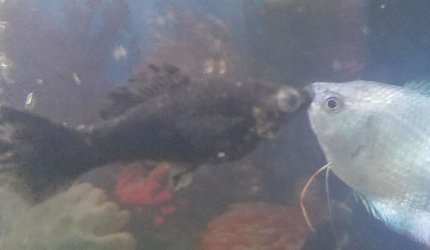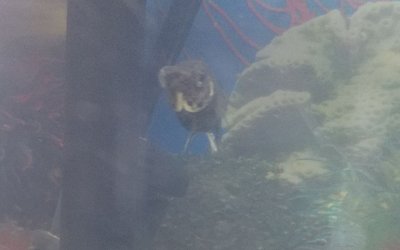Is there anything else I can do for her?
You can check your water quality for ammonia, nitrite, nitrate, pH and GH and post the results (in numbers) here.
Is the water cloudy?
Does the fish have a cream or white film over its body?
If yes to either of these questions, then you have a water quality issue that has caused an eye infection.
How long has the tank been set up for?
How often do you do water changes and how much water do you change?
Do you gravel clean the substrate when you do a water change?
Do you dechlorinate the new water before adding it to the tank?
How often do you clean the filter and how do you clean it?
What fish do you have in the tank?
How long have you had the molly for?
Have you added anything to the tank in the last 2 weeks?
----------------------
The best thing for cloudy eyes in fish is water changes. Do a 75% water change and gravel clean the substrate every day for a week. This will reduce the number of disease organisms in the water and fix any water quality issues you might have.
If the filter is more than 2 months old, clean it if it hasn't been done in the last 2 weeks. Wash filter materials in a bucket of tank water.
----------------------
If the water is fine and there is no improvement after a big water change & gravel clean, you can add some salt.
You can add rock salt (often sold as aquarium salt), sea salt or swimming pool salt to the aquarium at the dose rate of 1 heaped tablespoon per 20 litres of water. If there is no improvement after 48 hours you can double that dose rate so there is 2 heaped tablespoons of salt per 20 litres.
If you only have livebearers (guppies, platies, swordtails, mollies), goldfish or rainbowfish in the tank you can double that dose rate, so you would add 2 heaped tablespoons per 20 litres and if there is no improvement after 48 hours, then increase it so there is a total of 4 heaped tablespoons of salt per 20 litres.
Keep the salt level like this for at least 2 weeks but no longer than 4 weeks otherwise kidney damage can occur. Kidney damage is more likely to occur in fish from soft water (tetras, Corydoras, angelfish, gouramis, loaches) that are exposed to high levels of salt for an extended period of time, and is not an issue with livebearers, rainbowfish or other salt tolerant species.
The salt will not affect the beneficial filter bacteria but the higher dose rate will affect some plants. The lower dose rate will not affect plants.
After you use salt and the fish have recovered, you do a 10% water change each day for a week. Then do a 20% water change each day for a week. Then you can do bigger water changes after that.
----------------------
The following link has information on what to do if your fish get sick. It's long and boring but worth knowing. I recommend printing it out and reading it in bed to help fall asleep.
http://www.fishforums.net/threads/what-to-do-if-your-fish-gets-sick.450268/








